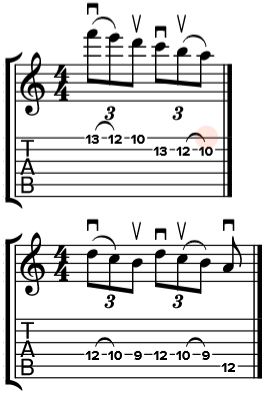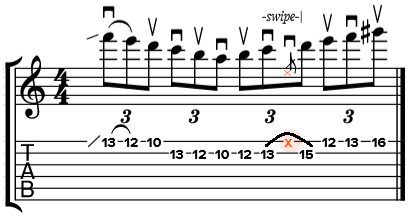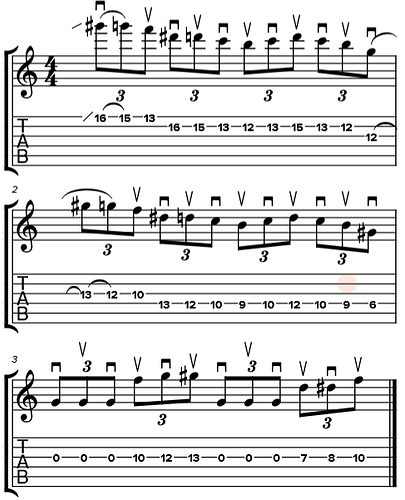Been trying to get this right, it’s been hard to figure out the turn around timing and some of the transitions after the two string arps. Everybody seems play it slightly different. What do you guys think?
Sounds awesome to me!
well done! This looks very articulate.
Sounds great! Must learn to add Malmsteen air kicks to this, then it’ll be perfect
I have no idea how people walk and play guitar, much less whip out some Kung Fu
Are you doing Down Down Hammer for the 2 string arps? It sounds like they’re picked kind of but pretty sure he plays them with the hammer on. Could be wrong
Thank you mate, I had used his this version to learn it. It sounds so much better/sweeter slower.
Ha, I might break something 
Interesting point, I’m picking down down up but I think I can try the hammer on as well. Does it sound very different?
Going back and listening to his instructional video recording of it, maybe he does go Down Down Up, I thought the Harpsichord in the original recording was just making it sound more percussive. Still, maybe trying with a hammer at the end of the arps might help with the turnaround? Just a thought.
From what I can tell, he’s picking the third note. I tried it both ways yesterday after you mentioned it, playing the note helps me track in time better.
I still have ambiguity over one note just before the open string sequence though. I can push through so that it’s in time but it still bugs me as a problem yet to solve. I think I might have to write it out into guitar pro to see if that will help identify the issue.
Fantastic Twangsta! Your Yngwie stuff is always worth listening to!
Thanks brother, much appreciated 
Nice job here man… very fluid. This intro is mandatory for Yngwie fans!
You using Marshall amps now??!!


Thanks bro. I’ve had a plexi clone for a while now, 1960B cab with T75 stock. The amp is an RR100 by Rokitt Retro. What your hearing here is my phone microphone. I pulled out the Lentz Croyden today, digging it more for some reason today, maybe it’s just a change.
i can swear that yngwie uses hammer ons for some of these triplet arpeggio sequences… at least thats what my ear tell me… i listen to the prelude before the solo in Bigfoot and it sounds like Hammers… even when i watch him play in live on the Alcatrazz concert.
Hes very deft in playing back then… slipping in hammers all the time to make things work. Hes the master…
You need to take a trip down gypsy jazz rest stroke lane to understand some of the tricks to use when legato’ing before escaping the pick with the upstroke. This means not only learning down, up, pull off/hammer on, but also down, rest pick, legato however many notes, unrest pick, up.
It just takes time getting use to resting on the string after every downstroke, but try learning some true rest stroke stuff which means always switching strings on downs no matter if ascending or descending musically. And also trying out some double down style phrasing lines. Just to get your picking use to resting naturally so you have better consistency with it.
Because when you start to get descent at down, rest pick, legato however many notes, unrest pick, up, this is when you can flow better to really play Yngwie stuff with much better flow that sounds legitimate.
This is a picking pattern I been messing with recently as it hides the blandness of down,up, pull off.

Doesn’t mean you have to do the rest stroke, but it will help you understand what I mean by making the flow sound more legitimate by learning to feel the rhythm by using rest strokes to know when to escape the pick on the up.
You can also utilize swiping tricks to help with escaping to maintain speed. However this is why I try to say to delve into gypsy jazz as it will help strengthen your downstroke power so you can do double down type stuff, or connect licks on back to back down strokes like how Joe Stump talks about here. But this can help ease the stress of getting back to the 2 string arpeggio phrase from a previous downstroke by using swiping to get the phrase to end on an upstroke to get back to the downstroke for the next phrase. You hide the swipe while you are doing the hammer on. Since if you were doing this with traditional rest stroke technique it would require a half rest stroke, going from a down on a higher string to a down on a lower string, which is the hardest maneuver. So you can use this swipe trick, or hammer on to the last note if you don’t want to swipe, while you learn half rest stroke.

Brother, been a bit busy, haven’t touched guitar for two days, will check it out today. Thanks!
I think I have to read that first para at least a couple of times, then watch some rest stroke picking material here.
this video he shows the mechanics of the technique. watch all of his gypsy jazz material and his gypsy jazz loops videos. however try to do the 2 nps diminished lines as double downs he tends to use alternate picking to go faster and probably not mess with his flow. just to get use to double downs for when you need to connect licks/phrase ideas, and also for those half rest strokes from a higher string to a lower string, down to a down which is the hardest to master. swing tempo practice helps to overcome these half rest strokes the best i have found through Christiaan’s insight into developing speed.
and really that swiping thing is kinda just to help you maintain speed and synchronization to not alter from the one way escape, however when you get use to hammering on to upstroke the e string you can alter the picking hand to divert around the string instead of swiping through it.
@Twangsta I started working on this after commenting,
I still have a few fits and starts you can see, and I play with DSX so those intro ascending runs are trickier (wanted to work on them for that reason), but feel like this video helped with the turnarounds:
EDIT: I guess that video was made private for some reason - I just found that focusing on sliding with the ring finger up to the 15th fret as the main theme restarts right after the 4th fret on the G string helped. Even leaving off that last note on the G string or playing it open, it’s kind of hard to notice that note vs getting the riff started over correctly.
Keep going. I think you should work on this with a metronome. Work on all the bits separately, at different speeds till you have it down. I’d start slow and work on one thing 18mins at a time.
There’s a triplets feel to the main riff that is very important, i could be wrong about it being triplets. Away from my guitar for a few days.
Yes there is that slide that’s necessary for the extended last turnaround, it’s the only way unless you find another finger position entirely.
It’s a fun time but its a grind for sure. I can play the main riff at redicilous speeds with the right feel now, but the turnarounds keep it real, need to slow down for them.






